|
The 1930s saw
great changes taking place in much of Penn; greater
man-made changes than ever before. The traditional
farming community rapidly gave way to a new urban
community as the old fields were replaced by
Wolverhampton’s new commuter belt.
The population
had been slowly increasing, and people were living
longer. The infant mortality rate had declined since the
beginning of the century, and the 1930 Housing Act
resulted in the demolition of some 2,738 houses in the
town, so that new homes would have to be found for over
11,000 people. All of this led to a housing shortage and
so new houses were built in several areas around the
town, including Penn. |
|
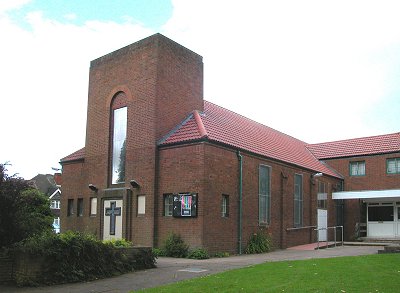
Springdale Church.
The community centre is on the right. |
The new
population would require all of the trappings of modern
life and the amenities that go with them. Shops and
schools would have to be built along with the houses, as
well as places of recreation and entertainment, and of
course churches.
By 1936 much of
the area to the south of Warstones Road, including
Spring Hill had been developed. In July of that year a
small group of Methodists, who called themselves the
Springhill Trust was formed. |
| At this time there were no
suitable churches in the area and so they purchased a
piece of land on the left-hand side of Springhill Lane,
on which to build a church. In September 1937 S. D. W.
Timmins was appointed as architect for the new church
and in November a building scheme was approved.
In the meantime a suitable venue had
to found for meetings. Initially at least two meetings
were held in the locality, at the home of Vic Cox and
consideration was given to open air services on the site
in Springhill Lane. The unsuitability of the ground
however, made this an impossibility. |
| Luckily there was one suitable
local building, the Penn Cinema.
This stood on Warstones Road,
where Somerfield’s supermarket is today, and was built
by the Penn Cinema Company, in the form of a plain,
simple, rectangular building, constructed from
Baggeridge bricks.
It officially opened on December
27th, 1937 with the film ‘A Day at the Races’ starring
the Marx Brothers. |
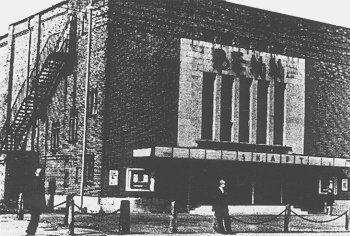
Penn Cinema. |
| The cinema’s manager, Mr. Harry
Shawcross was approached and he agreed to allow the
group to hold regular services on Sunday evenings in
the cinema lounge. A folding rostrum was constructed for
the purpose, and an organ loaned from Mr. and Mrs.
Fleet. |
|
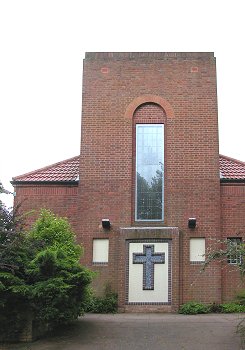
The church tower and original
entrance. |
The first
service on 18th September, 1938 attracted more
worshippers than expected and everyone had to move onto
the cinema balcony. From then on all subsequent meetings
were held in the main body of the cinema, with the organ
and the rostrum on the stage. The services continued
until September 1940 when they were abandoned because of
the wartime ‘black-out’ restrictions. The building plans
for the new church were also put on-hold because of the
war.
After the war in
1945, the church group decided to get the building plans
underway and invited the architect Mr. Moss, from
Crouch, Butler & Savage to meet them at the site and
prepare an outline scheme for the project.
At the time
there was a great demand for houses. No new building
work had been carried out during the war, and the
housing schemes of the 1930s had prematurely ended at
the onset of war. |
|
Several sites
were about to be developed for housing, including the
Warstones Estate, which would result in a great increase
in the local population and a greater need for a new
church in the locality. Possibly with this in mind,
Wolverhampton Corporation advised the Springhill Trust
to buy a site near to the Penn Cinema, in Warstones
Drive, which had already been considered to be a
suitable site for a new church.
In November 1948
Mr. Moss was asked to prepare an outline scheme for the
new church in Warstones Drive, and after quickly
completing his task, the scheme was handed to the trust
in January 1949. After much discussion, the trust held a
meeting in October 1950 to decide upon the matter. Some
members favoured the new scheme while others still
wanted the church to be built at Springhill Lane. After
considerable argument it was decided that the best way
forward was to find yet another site, that would be
agreeable to all, and build the church there.
|
|
By the middle of
1951 a suitable site occupying around 7,000 square yards
had been found in Warstones Road. On the 27th June it
was purchased from Holts Brewery for £550.
Mr. Moss was
appointed as architect and the recently formed
Springdale Trust and Building Fund Committee agreed to
accept a tender for the building work from A.M.
Griffiths & Sons Ltd. on 10th September, 1952. The
church would be built for £11,397 and the contract was
signed on 14th October.
In the meantime
the decision had been taken to open a Sunday school in
the canteen at Warstones Primary School, the 7 members
of staff being provided by Beckminster Sunday School.
They included Geoff and Margaret Race, Vic Cox, Doris
Horobin, Colin Smith and Stan Loweth. The Sunday School
opened on 15th June, 1952 and 33 children attended. On
the first day the school received the gift of a new
piano. |
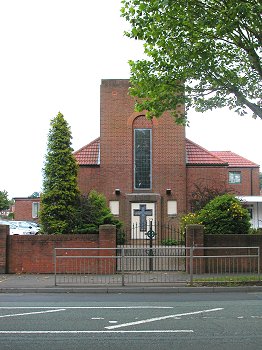
The view of the Church from Warstones
Road. |
|
Work progressed
rapidly at the new site and the foundation stone was
laid on 28th February, 1953. By October the buildings
were ready for use and the Springdale Trust held its
first meeting there on 13th October 1953.
The church
officially opened on 24th October and the first Sunday
services were held the next day. The details are as
follows:
|
11.00a.m.
The morning service held by the Rev. Dr.
Douglas Bebb.
|
|
3.00p.m.
The Sunday School met at Warstones Primary
School and marched in procession to the new
church, where they arrived at 3.20p.m. They
were welcomed by the Rev. Norman Parsons and
Sister Claire Powers, the resident
deaconess. |
|
6.30p.m.
The evening service held by the Rev. Norman
Parsons, who was assisted by Sister Claire
Powers. This was followed by Holy Communion. |
|
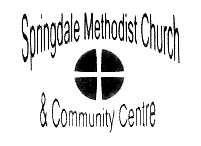 |
Over the next decade or so the
church continued to grow and new buildings were added.
1955 saw the addition of two vestries and a flat for the
use of the Deaconess. A Compton organ was installed in
February 1964.
The most ambitious scheme was the
building of the youth and community centre in 1967, at a
cost of around £20,000. |
|
The church
wanted to establish itself as the centre of the local
community in this part of Penn by providing buildings
for the use of outside organisations and societies, as
well as for the church. The project was greatly helped
by the church’s enthusiastic Minister, the Rev. Norman
Peck. The money for the project was raised partly by the
sale of some of the land, partly from trusts, and from a
number of money raising events.
The building was
designed by Crouch, Booth and Savage of Birmingham, and
built by Philip Blundell & Sons of Penn. It was
officially opened on 18th November, 1967 by Mr. G.C.
Stone, and followed by a service and dedication by the
Rev. Brian O’Gorman with greetings from Ken Healey and
Mr. R. Cooper.
In 1969 number
10 Woodhall Road was purchased to accommodate the new
Minister, the Rev Brian O’Gorman and his family, and in
1971 the church choir took part in the television
programme “Songs of Praise” which was televised from
Darlington Street Methodist Church.
A new Minister,
the Rev. Ken Hawkins was appointed in 1972 and the 21st
birthday celebrations were held in 1973. Events included
a children’s concert and family evening, a family
service and evening worship led by the Rev. R. Ankers,
and a choir concert. |
|
The Silver
Jubilee celebrations were held in 1978 in the form of “A
Spectacular Extravaganza” which took place on October
14th.
In January 1985
Springdale Church signed a Covenant with the three other
Penn Churches, Penn United Reformed Church, St.
Bartholomew’s Church and St. Michael’s Church, enabling
them to work closely together. |
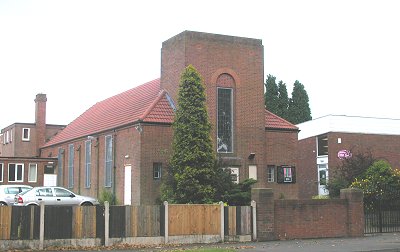
Another view of the church from
Warstones Road. |
|
Unfortunately
the Compton organ was proving to be unreliable and a
fund was started to raise money for a replacement. This
was installed in plenty of time for the 40th anniversary
celebrations in 1993.
In February of
that year Peter Churchill gave a recital on the new
organ, a Flower Festival was held in July and the
Wulfruna Ladies Choir gave a concert in October entitled
“Voices in Harmony”.
In 1994 a church
refurbishment scheme was set up and completed in 2002,
and 2003 saw a number of events to celebrate the 50th
anniversary of the church. The many events during the
year included a Jubilee Concert by the Wolverhampton
Orpheus Male Voice Choir, the launch of a new
development scheme, a church family outing to Little
Sutton, a concert by the Penn Singers, and a Harvest
Festival barn dance.
The events on
the anniversary weekend itself, in October, included
performances of the musical ‘Joseph and the Amazing
Technicolour Dreamcoat’, and Golden Anniversary
services.
The Community
Centre is used by many societies and groups including
the Women’s Fellowship, the Springdale Wives Group, the
Keep Fit Class, the Springdale Playgroup, the Multiple
Sclerosis Society, the Shell Group, the Scout and Guide
Groups, and many, many more. It has certainly been a
great success.
Since it’s
opening in 1953 the church has gone from strength to
strength and clearly achieved its objective of being at
the centre of the areas’ community life. It is greatly
appreciated by all who regularly attend church services
or use the facilities at the community hall.
|
Ministers at the church:
|
|
1953 – 1963
|
Sister
Claire Powers. |
|
1963 – 1965
|
Rev. Bill
Middlemiss. |
|
1965 – 1969
|
Rev.
Norman Peck. |
|
1969 – 1973
|
Rev.
Trevelyan Wills. |
|
1973 – 1983
|
Rev. Ken
Hawkins. |
|
1983 – 1985
|
Rev.
Richard Donoghue. |
|
1985 – 1990
|
Rev.
Phillip Harrison. |
|
1990 – 2000
|
Rev. Alan
Francom. |
|
2000 – 2007
|
Rev. Phil
Summers. |
|
2007 – 2012 |
Robert
Ely. |
|
2012 – 2017 |
Christopher Collins |
|
2017 – to date |
Teddy Siwila |
I would like to
thank Jackie Neilson for all of her help in producing
this brief church history.
 |
Return to the
previous page |
|
|